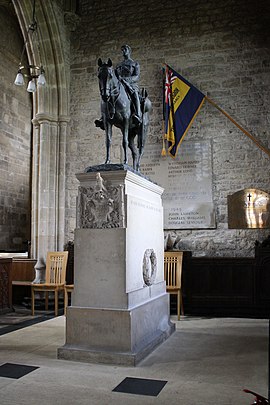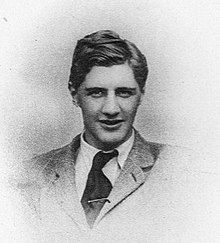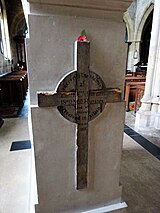Equestrian statue of Edward Horner
 | |
| Artist | Sir Alfred Munnings (statue) Sir Edwin Lutyens (plinth) |
|---|---|
| Completion date | 1920 |
| Type | Sculpture (Equestrian statue) |
| Medium | Bronze |
| Subject | Edward Horner |
| Location | Mells, Somerset, England |
| 51°14′32″N 2°23′28″W / 51.2421°N 2.3912°W | |
The equestrian statue of Edward Horner stands inside St Andrew's Church in the village of Mells in Somerset, south-western England. It was designed by the architect Sir Edwin Lutyens, as a memorial to Edward Horner, who died of wounds in the First World War. The sculpture was executed by Sir Alfred Munnings.
Edward Horner was the only surviving son and heir of Sir John and Lady Frances Horner of Mells Manor and a member of an extended upper-class social group known as the Coterie, many of whom were killed in the war. The group included Diana Manners who Edward pursued unsuccessfully for several years, his future brother-in-law - Raymond Asquith Julian Grenfell, Patrick Shaw-Stewart and Charles Lister. Shortly after the war broke out, he was a yeomanry officer in the part-time Territorial Force but he was keen to join the fighting on the Western Front and obtained a transfer to a cavalry regiment through his family's connections. He was wounded in May 1915, losing a kidney, and did not return to the war until early 1917. He was assigned a staff post but again secured a transfer to the front line. Shortly after his return to the fighting, on 21 November 1917, he was wounded again; he died the same day.
Lutyens was a friend of the Horner family, having designed multiple buildings and structures for them since the beginning of the 20th century. As well as Horner's memorial, he designed a memorial to Raymond Asquith (also in St Andrew's Church), and Mells War Memorial in the centre of the village. For Horner's memorial, Lutyens designed the plinth himself, and engaged the renowned equestrian painter and war artist Alfred Munnings for the latter's first public work of sculpture. The plinth is in Portland stone and set into it is Horner's original grave marker; the family's coat of arms is carved into the front, while the sides bear various dedicatory inscriptions. The statue is a bronze of a cavalry officer on horseback, bare-headed, with his helmet and sword on the horse's saddle. Lutyens was known for abstract and ecumenical themes in his war memorial designs, but the statue of Horner is an example of his use of more conventional imagery to commemorate an individual. Installed in the Horner family chapel in St Andrew's Church in 1920 at a cost of £1,000, it was moved to its present location in the church in 2007.
Biography

Edward William Horner (born 3 May 1888) was the third child of Sir John Horner, KCVO, of Mells Manor, and his wife Frances (née Graham), and their first son.[1] The family was reputed to be descendants of "Little Jack Horner", the subject of an 18th-century nursery rhyme. Sir John was a London barrister and later commissioner of woods, for which he was knighted in 1908. Frances was a prominent member of the Souls social group, whom she regularly hosted at Mells.
Edward was the last direct male heir of the Horner family, his younger brother (Mark) having died of
Like many contemporary men, especially those from aristocratic backgrounds, Horner felt a keen sense of patriotism fostered by his private education and by tales from imperial campaigns around the turn of the 20th century, especially the
Horner arrived first at
He was first assigned a staff post in Egypt but was again able to transfer to a fighting role in France in February 1917.[14] In October that year, the family's second home at Mells Park was destroyed by fire; Horner was given compassionate leave in early November and returned to the village to visit his parents. Returning to France, he was given command of a troop (16 soldiers and horses). The 18th Hussars were part of the Battle of Cambrai, where they were holding the village of Noyelles, south-east of Cambrai itself. He was hit in the groin on 21 November 1917 and evacuated to No. 48 Casualty Clearing Station near Ytres but died that evening.[15][16][17] He is buried in Rocquigny-Equancourt Road British Cemetery, maintained by the Commonwealth War Graves Commission.[18][19][20] The headstone for his grave in France contains the epitaph "Small time, but in that small most greatly lived this star of England", from Shakespeare's Henry V.[21]
Commissioning

Alfred Munnings was a painter specialising in horses. He volunteered for military service at the outbreak of war but was deemed unfit due to lack of sight in one eye. He volunteered to tend to army horses and was later recruited as a civilian war artist attached to Canadian cavalry. In 1919, he was beginning to move into sculpture. The Horner memorial was his first public work of sculpture, for which Lutyens commissioned him based on a pre-existing friendship.[30][31] The work led to several further commissions for equine statues, including from the Jockey Club for a sculpture of the racehorse Brown Jack at Epsom Downs Racecourse.[31][32] Munnings produced two models in clay for review by Lady Horner; he worked from photographs provided by Lady Horner and a live model in producing the statue. At one point, Munnings was so dissatisfied with the statue's head that he cut it off and re-cast it from scratch.[33]
Design and history

The memorial stands inside St Andrew's Church in Mells.
According to Colin Amery, who chaired an exhibition of Lutyens' work in the 1980s, "some of [Lutyens'] finest memorials and tombs" are to be found in Mells, and Edward Horner's memorial is one of "Lutyens' best and most moving tributes to the waste of life in the Great War".[24][1] In his public war memorials (particularly the Cenotaph and the various memorials based on it), Lutyens often used abstract and ecumenical designs, feeling that a different form of architecture was needed to convey the sense of sorrow at the enormous loss of life. Where he was commissioned to commemorate an individual, however, Lutyens was more open to conventional imagery, such as a statue of an officer.[39][40] According to Tim Skelton, author of Lutyens and the Great War (2008), the Horner statue is "widely considered to be one of the most moving of personal memorials to the [First World War]".[23] Lutyens' original design for Horner's memorial included pillars rising from the plinth to enclose the statue in a mausoleum, but this part of the proposal was not implemented.[23][41] Munnings' mould for the statue is on display at the Munnings Art Museum, in his former home and studio in Dedham in Essex.[42]
The statue was installed in 1920. It cost over £1,000 and was by far the largest and most elaborate of the several war-related monuments in Mells.[43] Frances Horner initially hoped for it to stand underneath the church's bell tower, but the suggestion prompted objections from villagers and the churchwardens, who were hesitant about having it in the church at all. Thus it was placed in the Horner chapel, on the north side of the chancel. In 2007 it was moved to the west end of the north aisle, as the church trustees wished to create space to allow more flexible use of the church.[2][41][44]
See also
Notes
- ^ The wooden memorial board in Mells bears the following wording:
EDWARD WILLIAM HORNER
LIEUTENANT IN THE EIGHTEENTH HUSSARS
WHO WAS BORN ON THE 3RD OF MAY 1888 AND DIED THE 21ST OF NOVEMBER 1917
HE WAS GREATLY LOVED IN HIS HOME AT MELLS BUT WITH EAGER VALOUR HE LEFT HIS HERITAGE AT THE
OUTBREAK OF WAR TO FIGHT IN FRANCE. SERIOUSLY WOUNDED AT YPRES HE RECOVERED AND RETURNED
TO HIS REGIMENT AND FELL AT LAST IN PICARDY WHILST DEFENDING THE VILLAGE OF NOYELLES
AGAINST THE GERMAN ARMY IN THE BATTLE OF CAMBRAI. THUS IN THE MORNING OF HIS YOUTH HE
HASTENED TO REJOIN HIS FRIENDS AND COMRADES BY A SWIFT AND NOBLE DEATH.
HIS GRAVE IS AT FINS NEAR ETRECOURT AND HIS ONLY BROTHER MARK IS BURIED IN THIS CHURCHYARD.
IN THEIR LIVES THEY WERE THE LOVE OF MANY AND HAVING DIED ARE NOT DEAD.[27] - ^ The placement of the tablet in France was arranged by Anglo-French writer Hilaire Belloc, who negotiated with the civil and ecclesiastical authorities. Belloc had lost his own son in the war, and the tablet to the memory of Edward Horner was erected opposite the tablet for Belloc's son which was in the entrance to the Lady Chapel in Cambrai Cathedral. Belloc also arranged for the erection of Lutyens' tablet to the memory of Raymond Asquith in Amiens Cathedral.[29] Lutyens travelled with Lady Horner and Katharine Asquith to France in the 1920s to view the tablets commemorating Edward and Raymond.[28]
References
Bibliography
- Amery, Colin; et al. (1981). Lutyens: The Work of the English Architect Sir Edwin Lutyens. London: ISBN 9780728703032.
- ISBN 9781850720416.
- Boorman, Derek (2005). A Century of Remembrance: One Hundred Outstanding British War Memorials. ISBN 9781844153169.
- ISBN 9780850523638.
- Brown, Jane (1996). Lutyens and the Edwardians. London: ISBN 9780670858712.
- Corke, Jim (2005). War Memorials in Britain. Oxford: ISBN 9780747806264.
- Dakers, Caroline (1987). The Countryside at War 1914–18. London: ISBN 9780094680609.
- Gliddon, Gerald (2002). The Aristocracy in the Great War. Norwich: Gliddon Books. ISBN 9780947893354.
- ISBN 9780907462590.
- ISBN 9780140297959.
- ISBN 9780701128470.
- Munnings, Alfred (1951). The Second Burst. London: Museum Press Limited.
- ISBN 9780300126587.
- ISBN 9780719024092.
- ISBN 9780712668224.
- Skelton, Tim; Gliddon, Gerald (2008). Lutyens and the Great War. London: ISBN 9780711228788.
- Speaight, Robert (1957). The Life of Hilaire Belloc. New York: Farrar, Straus & Cudahy.
- ISBN 9781107661653.
Citations
- ^ doi:10.1093/ref:odnb/49524. (Subscription or UK public library membershiprequired.)
- ^ a b c d Boorman (2005), pp. 138–139.
- ^ a b Gliddon, p. 320.
- ^ MacKenzie, p. 23.
- ^ MacKenzie, pp. 107–108.
- ^ MacKenzie, p. 111.
- ^ a b MacKenzie, pp. 141–142.
- ^ "No. 28873". The London Gazette. 18 August 1914. p. 6506.
- ^ The Children of the Souls - Jeanne MacKenzie, pub. Chatto & Windus 1986.
- ^ Dakers, pp. 25–26.
- ^ Dakers, pp. 86–87.
- ^ MacKenzie, p. 219.
- ^ "No. 29871". The London Gazette (Supplement). 19 December 1916. p. 12422.
- ^ MacKenzie, p. 249.
- ISBN 9780300195538.
- ^ Gliddon, pp. 320–321.
- ^ MacKenzie, pp. 257–258.
- ^ Dakers, pp. 97–100.
- ^ Skelton, p. 216.
- ^ Brown, p. 172.
- ^ "Horner, Edward William". Commonwealth War Graves Commission. Retrieved 18 October 2017.
- doi:10.1093/ref:odnb/34638. (Subscription or UK public library membershiprequired.)
- ^ a b c Skelton, pp. 81, 91.
- ^ a b Amery, p. 143.
- ^ a b Ridley, p. 283.
- Imperial War Museums. Retrieved 22 January 2018.
- ^ a b Reader, pp. 131–132.
- ^ a b Gliddon, p. 324.
- ^ Speaight, p. 372.
- doi:10.1093/ref:odnb/35148. (Subscription or UK public library membershiprequired.)
- ^ a b c Boorman (1988), p. 8.
- ^ Munnings, p. 127.
- ^ Munnings, p. 41.
- ^ Corke, p. 58.
- ^ Jenkins, p. 609.
- ^ Gliddon, pp. 324–325.
- ^ Borg, p. 111.
- Imperial War Museums. Retrieved 19 September 2017.
- ^ Winter, p. 107.
- ^ Hussey, p. 474.
- ^ a b Pevsner, p. 555.
- ^ Gliddon, p. 325.
- ^ Dakers, p. 210.
- ^ Historic England. "Church of St Andrew (1295876)". National Heritage List for England. Retrieved 22 April 2017.
Further reading
- Chapter XVI 'Edward Horner', pp. 142–146, in Smith, F. E. (1922). Points of View. Vol. 2. London: Hodder and Stoughton.


